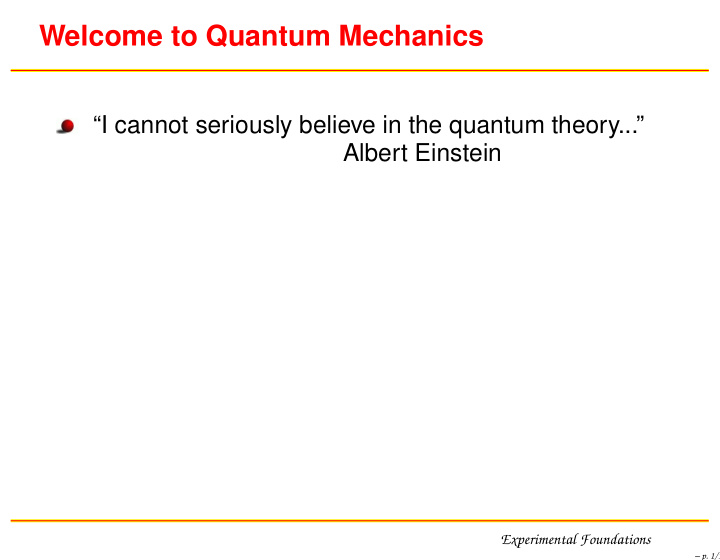



Welcome to Quantum Mechanics “I cannot seriously believe in the quantum theory...” Albert Einstein Experimental Foundations – p. 1/1
Welcome to Quantum Mechanics “I cannot seriously believe in the quantum theory...” Albert Einstein “The more success the quantum theory has the sillier it looks.” Albert Einstein Experimental Foundations – p. 1/1
Welcome to Quantum Mechanics “I cannot seriously believe in the quantum theory...” Albert Einstein “The more success the quantum theory has the sillier it looks.” Albert Einstein Experimental Foundations – p. 1/1
The Spectral Lines Problem Experimental Foundations – p. 2/1
The Spectral Lines Problem − → Experimental Foundations – p. 2/1
The Spectral Lines Problem − → − → Experimental Foundations – p. 2/1
A ‘Simple’ Example - Infinite Rectangular Well Potential V(x) Energy Levels n 10 9 x 8 0 a Energy 7 V ( x ) = 0 0 < x < a 6 5 = ∞ x ≤ 0 and x ≥ a 4 3 2 � 1 E n = n 2 � 2 π 2 2 � nπx � | n � = a sin 2 ma 2 a Experimental Foundations – p. 3/1
Blackbody Radiation A black body is an idealized physical body that absorbs all incident electromagnetic radiation, regardless of frequency or angle of incidence. In thermal equilibrium (at a constant temperature) it emits electromagnetic radiation called black-body radiation with two notable properties. 1. It is an ideal emitter: it emits as much or more energy at every frequency than any other body at the same temperature. 2. It is a diffuse emitter: the energy is radiated isotropically, indepen- dent of direction. Experimental Foundations – p. 4/1
Measuring The Blackbody Radiation Frequency Visible light λ ≈ 400 − 700 nm Measured by Lummer and Pringsheim (1899). energy R T ( ν ) dν = in the range ν → ν + dν time-area Experimental Foundations – p. 5/1
The Ultraviolet Catastrophe Rayleigh-Jeans Law u ( ν ) dν = 8 π c 3 k B Tν 2 dν in the range ν → ν + dν T - temperature. k B - Boltzmann constant. Experimental Foundations – p. 6/1
Planck’s Guess - the Boltzmann Distribution ∆ ǫ → 0 For ν → ν + dν Experimental Foundations – p. 7/1
Planck’s Guess - Do a Riemannian Sum ∆ ǫ � = 0 for small ν For ν → ν + dν Experimental Foundations – p. 8/1
Planck’s Guess - Do a Riemannian Sum, low ν ∆ ǫ = hν for small ν For ν → ν + dν Experimental Foundations – p. 9/1
Planck’s Guess - Do a Riemannian Sum - not as low ∆ ǫ = hν for not as small ν For ν → ν + dν Experimental Foundations – p. 10/1
Planck’s Guess - Do a Riemannian Sum - moderate ∆ ǫ = hν for moderate ν For ν → ν + dν Experimental Foundations – p. 11/1
Planck’s Guess - Do a Riemannian Sum - high ν ∆ ǫ = hν for high ν For ν → ν + dν Experimental Foundations – p. 12/1
Planck’s Guess - Do a Riemannian Sum - higher ν ∆ ǫ = hν for higher ν For ν → ν + dν Experimental Foundations – p. 13/1
The Ultraviolet Catastrophe Rayleigh-Jeans Law u ( ν ) dν = 8 π c 3 kTν 2 dν in the range ν → ν + dν T - temperature. k - Boltzmann constant. Experimental Foundations – p. 14/1
The Blackbody Radiation Scan of first showing of the COBE measurement of cosmic microwave background radiation at the American Astronomical Society meeting in January, 1990. Experimental Foundations – p. 15/1
The Blackbody Radiation COBE measurement of the cosmic microwave background radiation from J.C Mather et al. , Astrophysical Journal 354 , L37-40 (1990). Experimental Foundations – p. 16/1
Other Mysteries That Needed Quantum Mechanics Photoelectric effect Compton effect Spectroscopy Davisson-Germer Radioactivity Nuclear sizes Experimental Foundations – p. 17/1
Recommend
More recommend